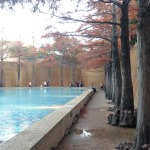AMTRAK DAY THREE
November 24, 2014
“In Fort Worth, you have to see the Kimball Museum,” Jinny said at lunch. “It’s been a couple years, but what I remember most is the brisket and the Kimball.” Jinny’s husband Jim had grown up on the same corner, 110th and Amsterdam Avenue, where my mom lived when she was two. We didn’t get to the Kimball. But the brisket was luscious.
Since I had done little to no research before I left, this was the way we discovered the cities we visited: either the advice of fellow passengers or by walking through them once we were there. We got to Fort Worth on a warm early Sunday afternoon, and saw our gleaming hotel just a couple blocks from the station. From our room, I looked down towards the station and glimpsed people walking through a large plaza of sorts.
Mom and I walked over to discover the Water Gardens: Philip Johnson and John Burgee’s undulating 70s modern landscape. Children, teens, adults and seniors all wandered through, climbed up or down, and gathered in the place of their choice. Canyons, waterfalls, pools, plateaus and mountains emulated the natural formations that inspired them, each created with concrete forms in 20-inch stepped increments. Grids and rows of trees lent shade, scale and color to the manmade landscape. Though concrete, its dark color and rough gravelly texture gave it unexpected warmth and earthiness.
We had just 24 hours in Fort Worth. After a luxurious sleep in a big fluffy bed (nothing like a tiny top train bunk to make you grateful for steady sleep), we treated ourselves to a workout and massage before re-boarding. Forty hours in the train left us stiff and achy.
“How do you like living here?” I asked Adria, my masseuse. She had moved to Fort Worth from San Diego years before.
“Oh I love it,” she said. “It’s a beautiful, friendly city and most of my family is here. And we’re doing our part to go green.” I had told her about my work and why we were training across America. It turns out Fort Worth has a new bicycling initiative with added bike lanes, bike racks and a bicycle share program with 300 bicycles and 35 stations. The city also hosts composting training and a “Green-Off” where two families compete to learn how to reduce their waste, energy use and water use with the help and support of City staff.







